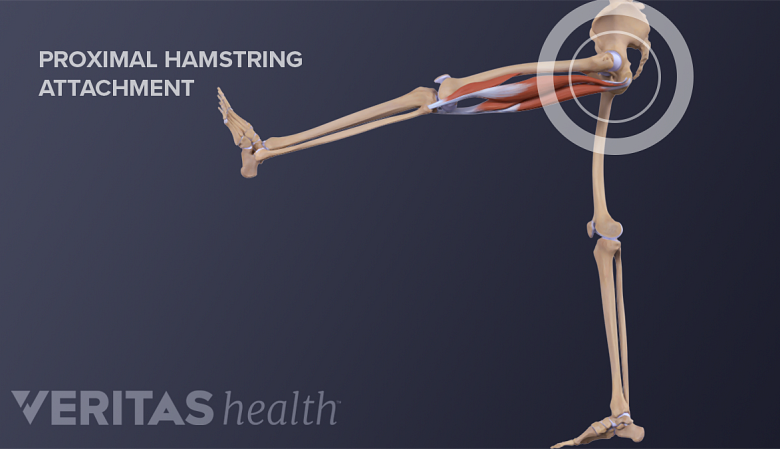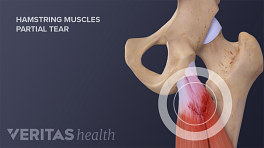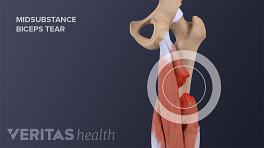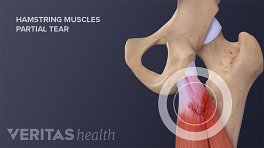Athletes who complain of deep buttock pain, pain when sitting, or deep, posterior, upper thigh pain may be suffering from high (proximal) hamstring tendon injury. Chronic high hamstring tendinopathy is becoming increasing recognized as a causative factor in both sitting and activity-related posterior hip pain. 1 Engebretsen A, Myklebust G, Holme I, Engebretsen L, Bahr R. Intrinsic risk factors for hamstring injuries among male soccer players: a prospective cohort study. Am J Sports Med 2010;38:1147-53. , 2 Gabbe B, Bennell K, Finch C, Wajswelner H, Orchard J. Predictors of hamstring injury at the elite level of Australian football. Scand J Med Sci Sports 2006;16:7-13. , 3 Chumanov E, Heiderscheit B, Thelen D. The effect of speed and influence of individual muscles on hamstring mechanics during the swing phase of sprinting. J Biomech 2007;40:3555-62. Unlike an acute tear, the pain usually comes on gradually and may be aggravated by repetitive activities, such as running or biking, and worsened by prolonged sitting.
See What Is the Difference Between Tendonitis, Tendinosis, and Tendinopathy?
High (proximal) hamstring tendon injury causes deep buttock pain, pain when sitting, or deep upper thigh pain.
In This Article:
- Chronic High (Proximal) Hamstring Tendinopathy
- Symptoms of Chronic High (Proximal) Hamstring Tendinopathy
- High (Proximal) Hamstring Tendinopathy Risk Factors
- Diagnosing Chronic High (Proximal) Hamstring Tendinopathy
- Treatments for Chronic High Hamstring Tendinopathy
- Minimally Invasive Treatments for Chronic High Hamstring Tendinopathy
- Surgery for Chronic High (Proximal) Hamstring Tendinopathy
How Does the Pain Develop?
The body has many tendons, which anatomically are fibrous tissues that connect muscle to bone. The proximal hamstring tendons connect the three hamstring muscles (the semimembranosus, the semitendinosus, and the biceps femoris) to the sit bone (ischial tuberosity), which is located in the buttocks at the bottom of the pelvic bone. These tendons are prone to injury, particularly in activities that require repetitive motion, such as running or rowing, or those that require prolonged sitting. (The distal hamstring tendons connect the hamstrings to the tibia, or shinbone, just below the knee joint.)
Hamstring tendon pain can become chronic when a damaged tendon fails to heal properly. It usually begins with one or more of the following conditions:
- A previous tear of the tendon (an acute injury) that failed to properly heal.
- Chronic tendinitis, an inflammatory tendon condition that can lead to non-inflammatory, degenerative changes to the structure or composition of the tendon (called tendinosis or chronic tendinopathy).
High (proximal) hamstring tendinopathy (sometimes spelled tendonopathy) can potentially cause significant pain and long-term disability. 4 Lempainen L, Sarimo J, Mattila K, Vaittinen S, Orava S. Proximal hamstring tendinopathy: results of surgical management and histopathologic findings. Am J Sports Med 2009;37:727-34. , 5 Puranen J, Orava S. The hamstring syndrome--a new gluteal sciatica. Ann Chir Gynaecol 1991;80:212-4. , 6 Fredericson M, Moore W, Guillet M, Beaulieu C. High Hamstring Tendinopathy in Runners: Meeting the Challenges of Diagnosis, Treatment, and Rehabiliation. Phys Sports Med 2005;33:32-43. This pain and disability may be avoided by recognizing symptoms, seeking an accurate diagnosis and getting prompt treatment.
Hamstring Muscle and Tendons
The three hamstring muscles are located at the back of the thigh:
- The semimembranosus muscle
- The semitendinosus muscle
- The biceps femoris
All muscles have origins and insertions, where their tendons attach muscle to bone. In the pelvis the hamstring origin occurs at the bottom of pelvis on a bone called the ischial tuberosity (sit bone). The semitendinosus and biceps femoris muscles blend together and share a common origin at the ischial tuberosity (sit bone) called the conjoint tendon. The semimembranosus tendon has a separate origin just to the outside (lateral to) the conjoint tendon origin. 7 Feucht MJ, Plath JE, Seppel G, Hinterwimmer S, Imhoff AB, Brucker PU. Gross anatomical and dimensional characteristics of the proximal hamstring origin. Knee Surg Sports Traumatol Arthrosc. 2014 Jun 15. [Epub ahead of print] PubMed PMID: 24929658.
While the conjoint tendon is the most commonly affected hamstring tendon, the symptoms, diagnosis, and treatment options for the semimembranosus tendon is the same.
- 1 Engebretsen A, Myklebust G, Holme I, Engebretsen L, Bahr R. Intrinsic risk factors for hamstring injuries among male soccer players: a prospective cohort study. Am J Sports Med 2010;38:1147-53.
- 2 Gabbe B, Bennell K, Finch C, Wajswelner H, Orchard J. Predictors of hamstring injury at the elite level of Australian football. Scand J Med Sci Sports 2006;16:7-13.
- 3 Chumanov E, Heiderscheit B, Thelen D. The effect of speed and influence of individual muscles on hamstring mechanics during the swing phase of sprinting. J Biomech 2007;40:3555-62.
- 4 Lempainen L, Sarimo J, Mattila K, Vaittinen S, Orava S. Proximal hamstring tendinopathy: results of surgical management and histopathologic findings. Am J Sports Med 2009;37:727-34.
- 5 Puranen J, Orava S. The hamstring syndrome--a new gluteal sciatica. Ann Chir Gynaecol 1991;80:212-4.
- 6 Fredericson M, Moore W, Guillet M, Beaulieu C. High Hamstring Tendinopathy in Runners: Meeting the Challenges of Diagnosis, Treatment, and Rehabiliation. Phys Sports Med 2005;33:32-43.
- 7 Feucht MJ, Plath JE, Seppel G, Hinterwimmer S, Imhoff AB, Brucker PU. Gross anatomical and dimensional characteristics of the proximal hamstring origin. Knee Surg Sports Traumatol Arthrosc. 2014 Jun 15. [Epub ahead of print] PubMed PMID: 24929658.








